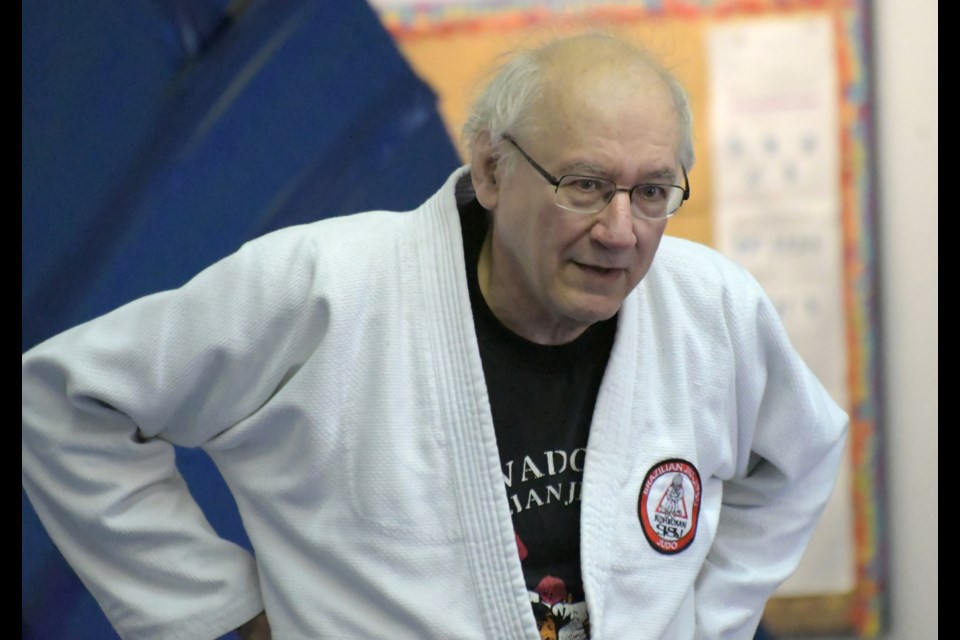Jim Stevenson of Guelph credits jiu-jitsu with helping save his life.
Not through a battle with any person, but with a disease.
“I was diabetic and the doctor told me that diabetics who do not become athletes die early,” the 67-year-old said. “That was in 1999 so I quickly lost from 240 lbs. down to 163 in six weeks by not eating and not having Coca-Cola.”
And he decided he’d find a physically taxing sport in which to participate.
After a couple of years of trying workouts in gyms and whatnot, he decided on jiu-jitsu.
“It was the most strenuous thing I could think of,” he said. “My high school wrestling coach said wrestling and Olympic rowing are the most strenuous things around so I thought 'Rowing in Canadian winters? Nah.' So I took up jiu-jitsui because it's similar and very strenuous.”
There was no athletic activity whatsoever in his background before he took up the martial art in a big way.
“I was fat and pudgy. I did Dungeons and Dragons – the computer game with your friends where you can drink Coca-Cola,” he said. “Once the doctor told me that diabetes means that you're going to die horribly in utter pain and they'll never give you enough pain killers because they don't want to addict you even though you're going to die in two weeks, I thought 'Let’s not do that.' So I took the most strenuous thing I could think of.”
That was when he was 48, a little older than most people are when they take up the sport.
“Damn right it is,” Stevenson said. “I am proof of that. I was paranoid. I grabbed my coach and wouldn't let him go until he had a bruise on his upper arm. That's not a good idea.
“But I just kept at it and strangely enough, the older you get the more stamina you have. The first Olympic marathoner was run by a 40-year-old Greek guy who never trained and was 140 lbs.”
That’s the story of Pheidippides, a courier who is said to have run from Marathon to Athens to announce the Greek victory over the invading Persians.
When Stevenson took up jiu-jitsu, he jumped in whole-heartedly, but his past lack of athleticism caught up to him.
“Since I retired I was (training) up to 12 times a week in six dojos, four times on a Monday and then I died,” he said. “Because of all the years I was fat, the arteries had built up some plaque and I had a quadruple bypass that year, 2016.”
However, it didn’t knock him out of the sport.
“So I was out for eight weeks and came back slowly and then by two months after that I was back to normal,” he said.
And after doing his grading and progressing through the various belts, at the end of April he became part of the largest class to be promoted to black belt at the Kohbukan Sisu Judo & Brazillian Jiu Jitsu dojo in Guelph. It’s usually one or two promotions, but there were five that day.
“It means I have to train harder, but I know stuff now,” Stevenson said of becoming a black belt.
It also means he gets to stand at the front, looking back at the group that is comprised of those with lesser belts.
“That's going to be different,” he said.
Then he looks at a club logo painted on a wall behind where the black belts stand.
“I've seen this for 17 years and now I have to look at that one. It's so different.”
And he’ll likely get a few more responsibilities with the dojo where he seems to be the usual greeting party. It’s said that he’s usually the first one to greet any newcomer.
“They'll probably ask me to teach stuff. Hopefully they'll have some warning,” he said.
But that won’t really be anything new for him.
“I've been teaching people on the sly for about a decade. The blue belts teach the white belts and that sort of thing. There's lots of teaching going on here.”
And while D and D might be in Stevenson’s past, he does keep meticulous records on some things – like the number of people he’s trained with since he took up jiu-jitsu.
“1,439,” he said. “From tournaments and mostly in this club and a few other clubs around, but most are from here. 1,439 people I've trained with.”
He has it written down, every name. Some of his clubmates have seen it and marvel at it.
And for Stevenson, that’s one of the things that’s so great about the sport.
“The friendliness of this place,” he said. “They take your arm, carefully straighten it and then you tap. So there's no real injuries. Only clumsy people do injuries. So it's friendliness. They're teaching people how to defend themselves from the knife-wielding maniac or something. Grab, twitch and down he goes.”



